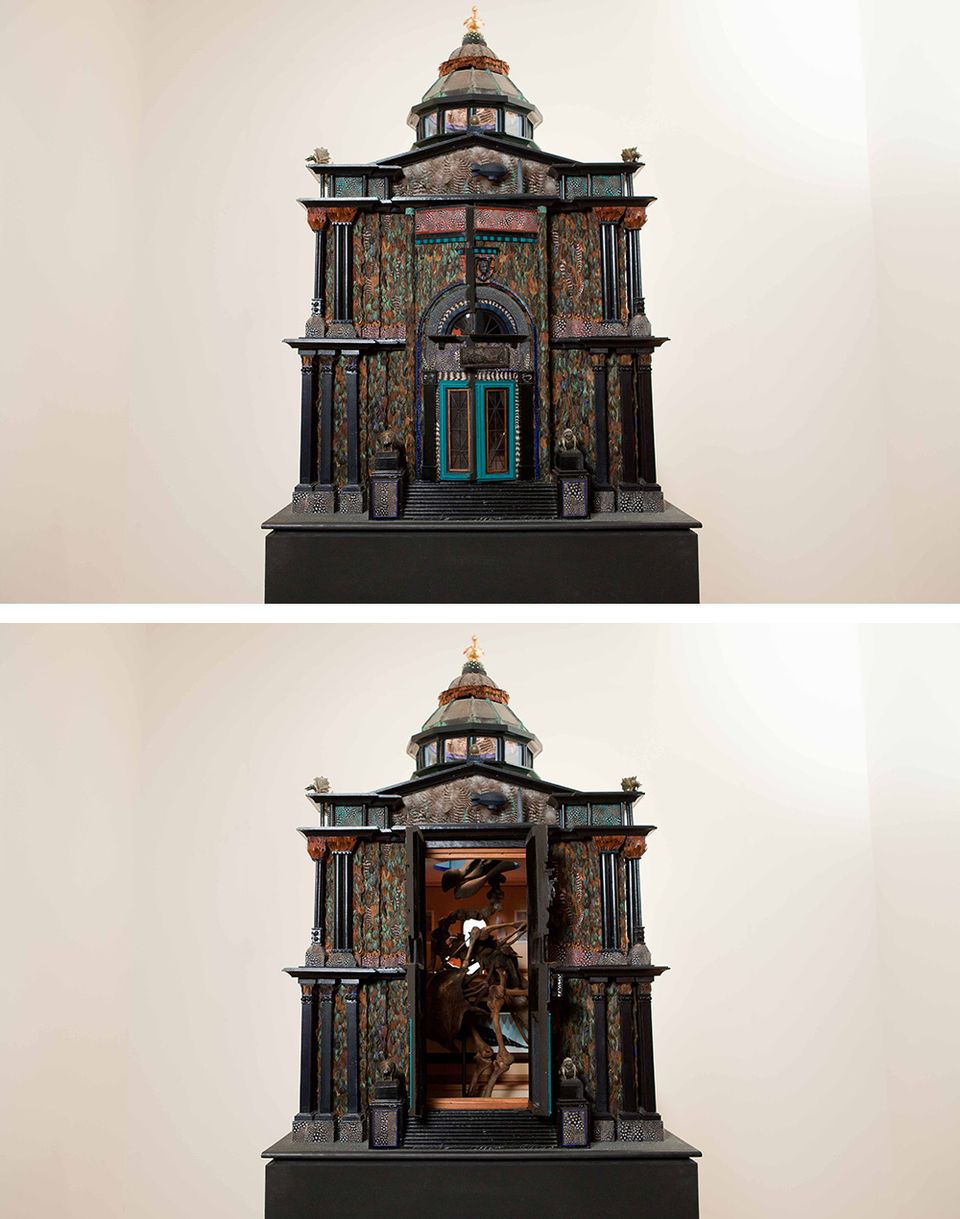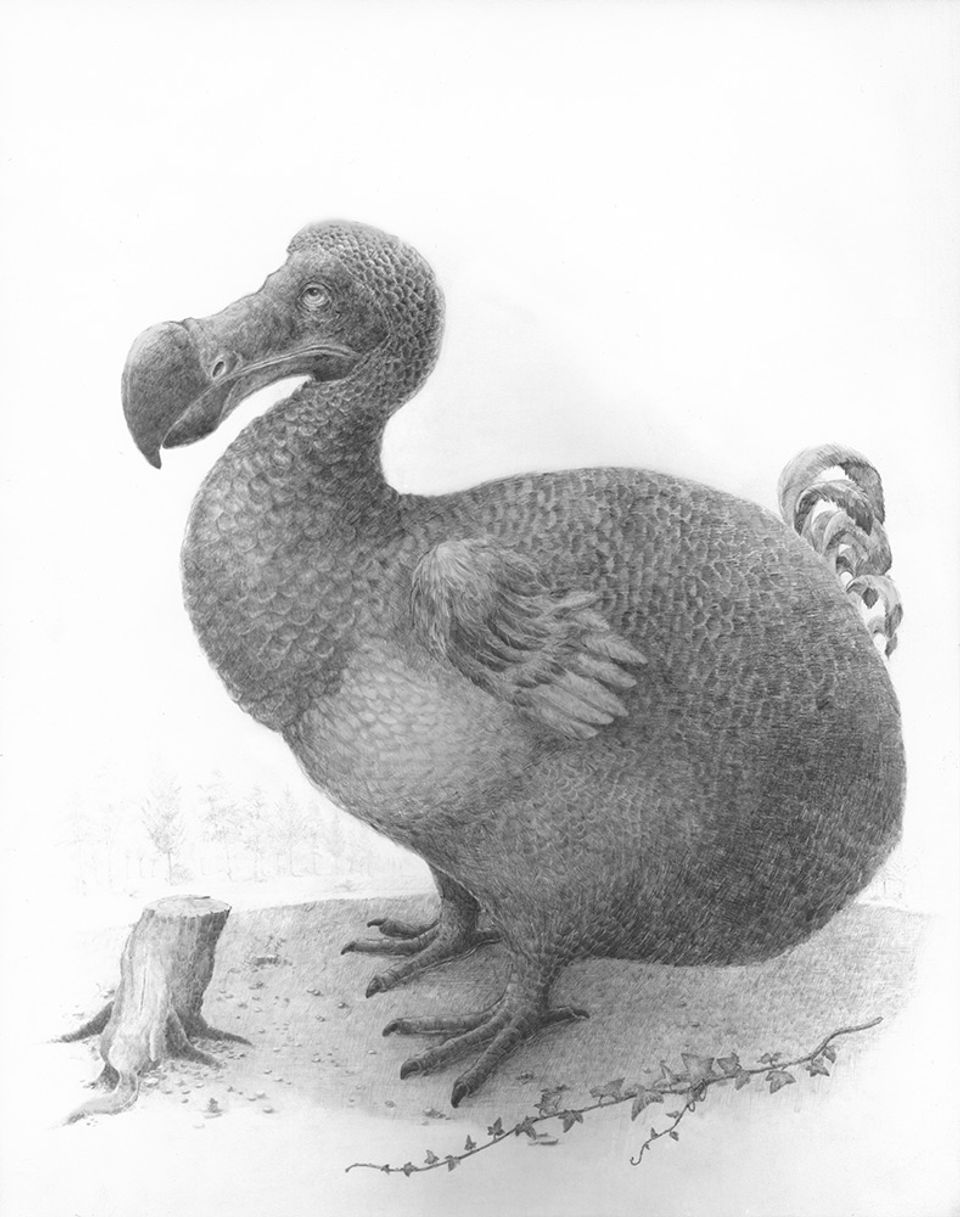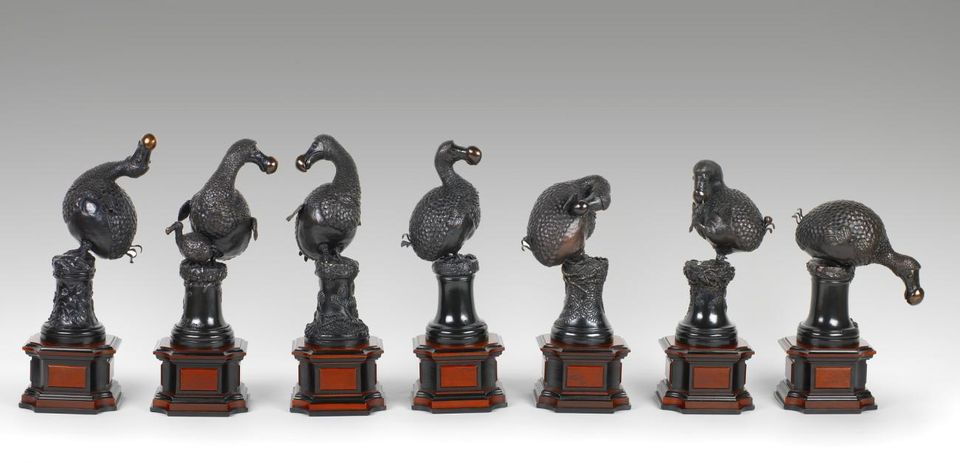Born 1953 in Muncie, IN
Lives and works in San Francisco, CA
David Beck’s meticulously crafted paintings, drawings, and sculptures evoke both curiosity and wonder. Each intimately scaled object references a range of sources, from medieval miniatures to American folk art and eighteenth-century mechanical toys. Beck has been depicting the dodo for nearly forty years, beginning with sketches based on an exhibit at the Museum of Natural History in New York. Beck’s diminutive sculptures evoke the surprise and discovery of childhood, but these playful curiosities belie a serious message about vulnerability, loss, and longing.
Image Gallery

David Beck, DODO MUSEUM, 1980, mixed media, 51 x 31 x 31 in., Allan Stone Collection, Courtesy of Allan Stone Projects, New York, © David Beck. Used by permission. Image courtesy of Hackett | Mill, San Francisco. Photography by Marie Chao

David Beck, DODO, 2007, graphite on paper, 53 x 42 in., Courtesy of the artist and Hackett | Mill, San Francisco, © David Beck. Used by permission. Image courtesy of Hackett | Mill, San Francisco

David Beck, Dodos En Suite, 2010, seven bronze sculptures, dimensions variable, Courtesy of the artist and Hackett | Mill, San Francisco, © David Beck. Used by permission. Image courtesy of Hackett | Mill, San Francisco
Videos
- Chapters
- descriptions off, selected
- captions and subtitles off, selected
This is a modal window.
David Beck speaks about his work in the exhibition The Singing and the Silence: Birds in Contemporary Art at the Smithsonian American Art Museum. The exhibition examines mankind's relationship to birds and the natural world through the eyes of twelve major contemporary American artists, including David Beck, Rachel Berwick, Lorna Bieber, Barbara Bosworth, Joann Brennan, Petah Coyne, Walton Ford, Paula McCartney, James Prosek, Laurel Roth Hope, Fred Tomaselli, and Tom Uttech.
Supposedly, the Portuguese had found it several decades before that, and maybe Arab travel – or Arab explorers or traders had found it even hundreds of years before that, but the Dutch were the first people to actually write about it, and they colonized the island, so completely uninhabited except for giant tortoises, dodos, different parrots, there’s a whole group of animals and in fact – so that’s where the first pictures of it came from, sailors doing drawings and things like that, and they’re very different than what we see now, but there was an artist named Roelant Savery, who did a lot of paintings, and he was doing these things in probably 1620, something like that.
Sort of these paintings of Eden with every animal, and there’s a tiny little dodo in the corner, and that’s sort of the basis for anybody who does dodo imagery, the kind of go-to that guy’s stuff. Also, there was, I think that there was a complete dodo, some made it to Europe, and I think that there was one in particular that made it to the Ashmolean Museum in England, and then the Oxford Museum got it, but all that was left was basically a head and a foot. And there’s this big story about how it had been stuffed, and they had a complete specimen, except it was so poorly done in the 1700s that it all fell apart, so they threw it in the bonfire, but like a maintenance man had found the head and went ahead and saved it. Turns out that’s all in the literature you read about the dodo, but it’s supposedly not true at all, it never happened, but there is a head that’s in a box that’s in Oxford.
I think I made a sculpture in about ’76 or ’77, and the sides open up, and inside is like a little paradise of dodos, and they’re all kind of looking around. Some are looking straight up and some I think are falling from the sky. That was one of the first. And then I continued, and I decided to make the “Dodo Museum,” and I think I finished that maybe two or three years later.
It’s a little building that’s sort of Victorian in nature in a sense, but it’s covered in feathers, and the inside of it has an atrium, and when you open the façade of the building itself, you see there’s a skeleton of a dodo inside, so it takes up two floors, so you have this sort of funny little scale thing happening, and then on the walls of the little museum inside are paintings that are taken from the Unicorn Tapestries that they have at the cloisters, and I replaced the unicorn with the dodo, and I told the story of the dodo being discovered by Europeans, and that sort of being, well, being taken, you know? Being killed by dogs and that sort of thing. But also, in there, there is a tiny head, and a tiny foot, that are on little pedestals, and there’s a skylight, so that looks nice, so the light filters down. And outside, on the podiums outside, the steps going up, there’s a monkey and a pig, sort of ominous, and on the sides at the top, there’s a gold dodo that’s on top of the dome, and then there’s a dodo on the side, on like the third floor. And then on the other side, it’s his bottom, so it kind of goes all the way through.
And there’s two skulls, come to think of it. On the window in the back, and they look like little tiny skulls, but in fact, they’re seed pods from snapdragons, but they look exactly like tiny bird skulls. It has a very dark kind of look to it in a funny sort of way. I mean, dodos have this sort of humor to them, but there’s a little bit of an edge to it, because they are, you know. And there’s all those sayings about dodos: “dead as a dodo,” “gone the way of a dodo,” and then there’s “dumb as a dodo,” things like that.
The bronze piece is “Dodo En Suite.” There’s seven sculptures and their poses. A lot of the poses are actually quite precarious, and that’s sort of done on purpose in that the dodo itself didn’t… of all of that sort of ideas are precarious. So there’s a dodo that’s preening, he’s leaned over, he’s on one leg and has his foot up in the air. There’s one looking straight up and almost tilting back, and that reminds… that’s actually kind of somewhat of a helpful pose, but also reminds of all these tourists, in any kind of metro. For some reason as they do that, their mouth opens at the same time, it’s almost as if their jaw is connected to their belt or something like that.
The “Dodo” drawing was, I started… I generally work pretty small, but this is actually one of the largest pieces, largest drawings I’ve ever done, and the way that this came about was that I found myself just drawing dodos again. I had stopped, I had sort of figured that I had gone through that and I didn’t really need to make any more, and I found myself constantly drawing pictures of dodos again, and then there was this cold snap in California, and you know, our houses aren’t heated that well, so I couldn’t really work in my studio, and I had a heater that’s mounted on the wall, so I took this really big piece of paper and nailed it above the heater, and I stood in front of my heater for, you know, basically just to stay alive, or just to stay warm, and I just started drawing this giant dodo. And so that’s how that, actually, you know, little natural disaster. But that’s how I started doing that drawing.
And there’s a stump in front of it, and that’s right outside my door, so I could turn around and look out the window and draw a stump and I put that in there, and I put the stump in, and it’s kind of a symbol. In a graveyard you kind of see a lot of stumps, or one, you know, it’s kind of clamped down on life. In the background is actually from somebody’s house that I know lives down south of here, but yeah. So, it’s kind of funny to sit here and doing a piece of art because you’re trying to stay warm.
I prefer to work in a very intimate scale. I feel better, it just comes more natural to me, and it’s also a way of communicating one-on-one with a person, an audience or something like that, and it’s also a way of sharing, for them, which I like to think about, like I show you something tiny, and then you show your friend something tiny, but only one or two people can look at it at the same time. Like, even the larger pieces, the openings. Like say for instance, the “Dodo Museum,” it’s gonna be tough for more than one or two people to actually look inside, you know. Because the openings are small, and they’re intentionally small, so that one person will have a kind of direct, a real direct, an uninterrupted sort of experience.
- Chapters
- descriptions off, selected
- captions and subtitles off, selected
This is a modal window.
David Beck's Mvsevm was commissioned by SAAM in 2006 to commemorate the reopening of the museum after its renovation.
A lot of people think that I make miniatures. I don't really see them as miniatures. I see them more as like an intimate scale, a way of like connecting with someone on a more immediate and more focused way. With the really small pieces, I think it goes right into your senses faster. You become part of it, you get lost in it.
I go to the library a lot. I like the smell of books. Sometimes I take my sketchpad, and I do a lot of drawings. Then for this piece, I've made several different models. In terms of carving something, if it's really complicated, I'll sometimes make a model, sometimes a paper cutout, or a tracing, or something like that. That way I can block it out quicker and see if it works. I would say, most, all the time, I have some sort of sketch.
When I started this piece, I was thinking about the histories of museums. They started when the Europeans were leaving Europe and discovering the New World, so they would bring back oddities like seashells that they'd never seen before. Guys would collect them, and then they built cabinets to hold them in. Later those cabinets became whole rooms, and then those rooms of objects eventually made their ways into museums.
The drawers are more of a cabinet feature because I wanted parts of it to be like a cabinet, the cabinet of wonders. What they contain are animal-type things that the Wilkes Expedition would have brought back.
I thought that it would be important to have some portraits, portraits of artists. I experimented with different papers and things like that at first, and I wasn't getting the fine detail that I wanted. Then I went back, and I actually got some parchment, some sheepskin parchment. I read up on that, how you get the grease off and mount it a certain way so it doesn't warp.
Then I had to figure out a way how to learn how to paint portraits, so I went to the library and got a book on how to paint portraits. I have Gorky, who I liked when I was very young. Stuart Davis, Romaine Brooks, who is fantastic. Elie Nadelman, who is one of my favorites.
I wanted to incorporate a lot of history of your building within my piece. Your museum used to be the Patent Office Building, the POB. It used to be that when you had an idea for an invention, you were required to make a working model. All of those were on display at one time. But I didn't really want to replicate actual patent models like a sewing machine. I made a sewing machine, but I took it from a Walter Murch painting. There's a gumball machine by Thiebaud. The beer can is by Jasper Johns. The light bulb, not Edison, but Jasper Johns’ lightbulb, packaging, Campbell soup cans, things like that, and some really terrific inventions like the electric chair that came from Andy Warhol. The sole of a shoe from Philip Guston, which I like a lot.
The patent models seem to be a very important part of the history of the building. This piece, it has so many different aspects to it, and I do so many different types of things. I don't like to repeat myself, and I like to experiment a lot with different techniques and different things. I want to do everything, basically. I'd like to learn how to do everything. I don't know, that's, what I guess inspires me. It's kind of fun.













